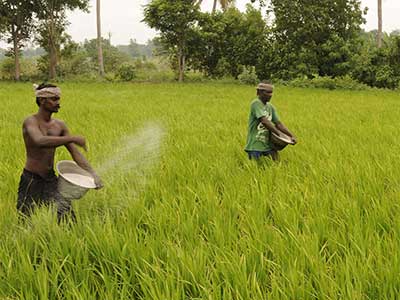Date: 27/04/2023
Relevance: GS-3: Major crop-cropping patterns in various parts of the country, – different types of irrigation and irrigation systems storage.
Key Phrases: balanced fertilization, di-ammonium phosphate, muriate of potash, nutrient-based subsidy, organic manures, Loss of biodiversity, Reduced crop yields.
Context:
- India's current fertiliser pricing policy has not been successful in promoting balanced fertilisation, resulting in excessive use of urea and harming the health of the soil.
Current Scenario:
- Urea consumption has gone up by over a third compared to the pre- (nutrient-based subsidy) NBS year of 2009-10.
- Sales of urea have crossed an all-time high of 35.7 million tonnes in 2022-23.
- Farmers are over-applying urea, leading to declining nitrogen use efficiency and crop yield response to fertilisers.
- The MRP of urea has been unchanged at Rs 5,628 per tonne since November 2012, while the corresponding per-tonne MRPs of other fertilisers are much higher.
- For example per-tonne MRPs of Rs 27,000 for di-ammonium phosphate, Rs 34,000 for muriate of potash and Rs 28,000-31,000 for most complexes.
About The Nutrient Based Subsidy (NBS) Regime:
- The Nutrient Based Subsidy (NBS) Scheme has been implemented since April 2010.
- Implemented by- The Department of Fertilizers, Ministry of Chemicals & Fertilizers.
- A fixed rate of subsidy (in Rs per Kg basis) is announced on nutrients namely Nitrogen (N), Phosphate (P), Potash (K), and Sulfur (S) by the government on an annual basis.
- The per Kg subsidy rates on the nutrients N, P, K, and S are converted into per tonne subsidies on the various P&K fertilizers covered under the NBS Policy.
- The subsidies on Phosphatic and Potassic (P&K) are determined taking into account the international and domestic prices of P&K fertilizers, exchange rate, inventory level in the country etc.
- NBS policy intends to increase the consumption of P&K fertilizers so that optimum balance (N:P:K= 4:2:1) of NPK fertilization is achieved.
- The NBS regime has faced several challenges and failures such
as:
- Subsidy rates have not been adjusted to reflect the changing prices of fertilizers.
- Subsidies have been distributed unevenly, with farmers in some regions receiving higher subsidies than others.
Consequences of Imbalanced Fertilisation:
- Reduced crop yields: If the soil is deficient in essential nutrients, crop yields can decline, leading to reduced productivity and lower profits for farmers.
- Soil erosion: Overuse of chemical fertilizers and pesticides can lead to soil degradation, increasing the risk of soil erosion. This can lead to reduced soil fertility and loss of topsoil, which is rich in organic matter and essential nutrients.
- Water pollution: Overuse of fertilisers can lead to nutrient run-off, which can cause eutrophication in nearby water bodies. This can result in algal blooms, which can be harmful to aquatic life and also reduce the quality of drinking water.
- Loss of biodiversity: Deteriorating soil health can lead to a loss of biodiversity in the soil, which can impact the overall ecosystem. Soil organisms play an essential role in nutrient cycling, plant growth, and carbon sequestration.
- Climate change: Soil degradation can lead to the loss of carbon from the soil, contributing to climate change. The soil is an essential carbon sink, and when it is degraded, the stored carbon is released into the atmosphere.

Measures Taken by the Government to Address the Issue of Imbalanced Fertilization in India:
- Promotion of organic farming:
- The government is promoting organic farming practices by providing subsidies, training, and technical support to farmers.
- This includes the use of natural fertilizers like compost, vermicompost, and green manure.
- Use of micro-nutrient fertilizers:
- The government is promoting the use of micro-nutrient fertilizers that contain essential nutrients like zinc, iron, and boron, which are required in small quantities but are essential for plant growth.
- Distribution of soil health cards to farmers:
- The government has launched a soil health card scheme, under which farmers are provided with soil health cards.
- These cards contain information about the nutrient content of the soil and suggest appropriate fertilizers for balanced fertilization.
- Launch of schemes such as Pradhan Mantri Krishi Sinchai Yojana and Paramparagat Krishi Vikas Yojana: These schemes provide financial assistance to farmers for the purchase of balanced fertilizers and promote the use of organic and natural fertilizers.
- Promotion of crop rotation and mixed cropping: The government is promoting crop rotation and mixed cropping practices, which help to maintain the soil fertility and reduce the dependence on chemical fertilizers.
- Development of new fertilizer formulations: The government is promoting research and development of new fertilizer formulations that are balanced and environment-friendly.
Way Forward:
- Bring urea under NBS and link subsidy to its nutrient content of 46% nitrogen.
- Decontrol the MRP of urea to reflect its true value and incentivise farmers to use fertilisers more judiciously.
- Replace NBS with a flat per-acre subsidy to encourage judicious use of fertilisers (including organic manures).
Conclusion:
- While the government has taken several measures to address the issue of imbalanced fertilization in India, there is still a long way to go to ensure the effective implementation of these measures.
- More efforts are needed to raise awareness among farmers about the benefits of balanced fertilization and the use of organic fertilizers, and to ensure that subsidies are distributed fairly and reflect the changing prices of fertilizers.
Source: The Indian Express
Mains Question:
Q. Explain the nutrient-based subsidy (NBS) regime and its failures. What measures have been taken by the government to address the issue of imbalanced fertilisation in India? (250 Words).






















